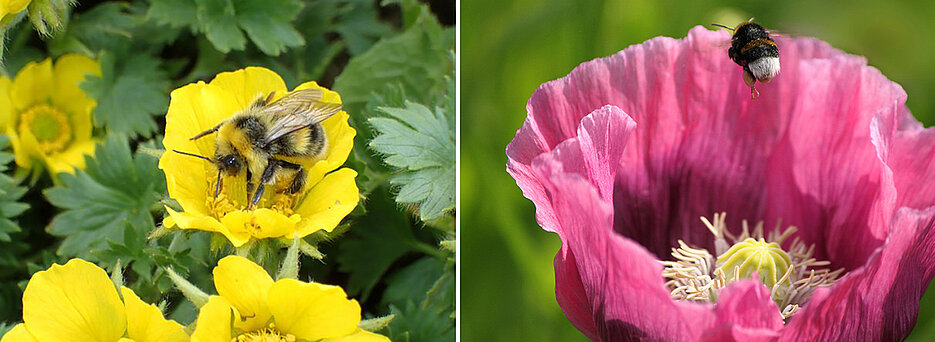Flower Patterns Make Bumblebees More Efficient
01/18/2023The search for nectar costs insects a lot of energy, so they have to be as efficient as possible. Colourful patterns on the petals can help with that.

Be it mallow, foxglove or forget-me-not: many flowers bear colourful patterns, which are known as nectar guides in biology. They are assumed to show the pollinating insects the shortest way to the nectary. This guiding function could increase the efficiency of the insects in their search for food, and at the same time improve the pollen dispersal of the plant.
A team from the Biocentre of Julius-Maximilians-Universität Würzburg (JMU) in Bavaria, Germany, has now deciphered the individual steps through which flower patterns increase the efficiency of terrestrial bumblebees (Bombus terrestris) for the first time. They demonstrate that nectar guides reduce the time needed for the bee’s entire interaction with a flower by up to 30 percent – from approach to finding the nectar to departure.
What the flower patterns do
Surprisingly, flower patterns do not shorten the actual nectar search: After landing on a patterned flower, the bumblebees did not find the nectar any faster than on a flower without a pattern. However, the flower patterns shortened the approach flight time and ensured a strategically favourable landing position. Thus, they act like markings on a runway and help the bumblebees to coordinate their approach, reports the team led by Anna Stöckl and Johannes Spaethe in the journal Functional Ecology.
Flower patterns also shorten the time until take-off: the insects stayed significantly shorter on patterned flowers after collecting nectar. "Bumblebees very often run to the edge of the petals for take-off," explains Johannes Spaethe. They may find this take-off site more quickly if they can orient themselves to a pattern.
This study was conducted using video tracking. The bumblebees visits to artificial flowers were analysed in the laboratory. The artificial flowers presented different pattern types or none at all; all of them had nectar on them.
How the research continues
Next, the JMU team will investigate how the glossy surface that occurs on some flowers affects the interaction with pollinating insects.
This work is conducted in cooperation with Casper van der Kooi, who is currently a Humboldt Foundation fellow at the JMU Biocentre. Anna Stöckl, who recently moved to the University of Konstanz and is setting up an Emmy Noether junior research group there, will also remain a cooperation partner.
Publication
Flower patterns improve foraging efficiency in bumblebees by guiding approach flight and landing. Robin Richter, Alexander Dietz, James Foster, Johannes Spaethe, Anna Stöckl. Functional Ecology, 8 January 2023, Open Access: https://doi.org/10.1111/1365-2435.14262
Popular science summary of the article
Contact
Dr. Anna Stöckl, anna.stoeckl@uni-wuerzburg.de
Dr. Johannes Spaethe, johannes.spaethe@uni-wuerzburg.de









